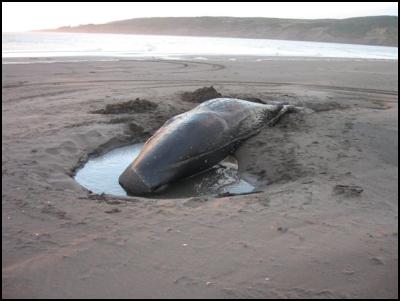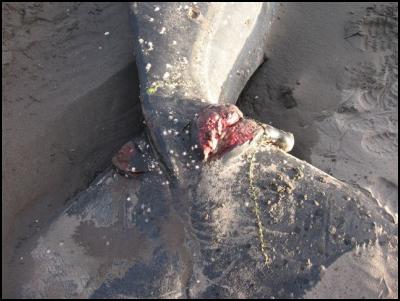Sperm Whale and Longline Interaction
Sperm Whale and Longline Interaction

Click to enlarge

Click to enlarge
08 August 2006
Sperm Whale and Longline Interaction
Last month, a juvenile (7.2m) female sperm whale washed up at Port Waikato, with some visible injuries inflicted from an interaction with fishing gear.
The animal’s tail had been ensnared in heavy gauge monofilament long-line, indicating entanglement in a commercial long-line. The fishing gear had cut deeply into the surrounding tissue which indicates that the animal had been trailing gear for many months.
Katja Geschke, veterinarian from Wellington Zoo was unable to determine the cause of death from photos taken at the scene, but was confident that the tail wound would have been painful for the individual and would have ultimately been detrimental to the animals’ welfare.
“It’s possible that the wound lead to septicaemia (blood poisoning) which could have been the primary cause of death, but without further scientific evidence, we simply can’t say”
The Department of Conservation took tissue samples from the animal, so a definitive cause of death may yet be established from further testing. It’s the department’s intention that the Institute of Veterinary and Biomedical Science, Massey University will help analyse these samples.
“The fact that the whale was covered in many parasitic whale lice also suggests that it had been doing poorly at sea for an extended period before it died, and that its immune system was suppressed”.
The fact that this whale was a juvenile female means it is unlikely that this animal was part of the well known Kaikoura population which consists almost exclusively of males. It is more likely that this animal came from waters outside of New Zealand and has strayed into coastal New Zealand waters as its condition deteriorated.
Sperm whales and killer whales have both been recorded taking hooked fish off commercial long-lines in the South Pacific, a behaviour known as depredation. Other marine mammals as well as sharks also take fish from long-lines. This opportunistic feeding frustrates many commercial fishers as catch is lost and or damaged along with fishing gear.
Sperm whales have been frequently recorded as becoming entangled in long-line fisheries for Patagonian toothfish in Antarctic waters. However, this is the first incident in New Zealand where a stranded sperm whale has been found in association with commercial fishing gear.
Before DOC rangers could make it to the scene a number of teeth were stolen from the carcass. The person who took these teeth and is holding them now is in contravention of the Marine Mammal Protection Act 1978. Penalty for holding marine mammal body parts without a permit is up to six months imprisonment or a fine of up to $250 000.
The carcass will be left where it is to decay naturally as it is on a relatively isolated section of beach and does not pose a human health threat.
Early in July a humpback whale became entangled in a cray-pot line off the Kaikoura coast. Despite their best efforts and because of fading light a specially trained DOC team could not free it on the day it was reported. This whale has not yet been seen again.
These incidents highlight the ongoing concern of marine mammal interactions with a variety of fisheries. The interactions vary widely depending on species and fishery; and any mitigation techniques need to be tailored to suit each type of interaction.
ENDS
Sperm
whales:
Males grow to lengths of 18m, females 12m
Feed
primarily on squid, octopus and fish of little commercial
value at great depths
Sperm whales can dive to depths of
2000 m and can stay submerged for up to 90
minutes
Spermaceti oil was once highly prized by whalers
for making medicines and
candles


 Gordon Campbell: On The Left’s Electability Crisis, And The Abundance Ecotopia
Gordon Campbell: On The Left’s Electability Crisis, And The Abundance Ecotopia NZ Government: PM Sends Condolences On Passing Of Pope Francis
NZ Government: PM Sends Condolences On Passing Of Pope Francis NZDF: Battlefield Remains Unearthed By Wildfires In Gallipoli Covered Over By Kiwi Team
NZDF: Battlefield Remains Unearthed By Wildfires In Gallipoli Covered Over By Kiwi Team NZ Police: New Zealand Police team up with Z Energy, NZTA and ACC to remind Kiwis to drive safe this Easter
NZ Police: New Zealand Police team up with Z Energy, NZTA and ACC to remind Kiwis to drive safe this Easter NZCAST: NZCAST Leads Ongoing Cross-Agency Collaboration To Break Down Barriers For Survivors Of State Abuse
NZCAST: NZCAST Leads Ongoing Cross-Agency Collaboration To Break Down Barriers For Survivors Of State Abuse Regional and Unitary Councils Aotearoa: Regional And Unitary Councils Back A Practical FWFP System
Regional and Unitary Councils Aotearoa: Regional And Unitary Councils Back A Practical FWFP System NZ Government: Stay Safe On Our Roads This Easter
NZ Government: Stay Safe On Our Roads This Easter


